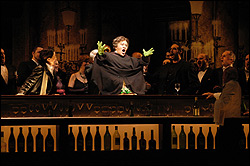Based on the fantastical stories of echt-romantic German poet E.T.A. Hoffmann, The Tales of Hoffmann (at McCaw Hall through Saturday, May 22; 206-389-7676),Jacques Offenbach’s only grand opera, remains one of the trickier standard-rep pieces to stage—four operas in one, with a huge cast. In adapting three of Hoffmann’s pieces, librettist Jules Barbier innovatively made Hoffmann himself the protagonist and devised a framing device: Besotted with an imperious diva named Stella, the poet goes on a bender and recounts to his fellow drinkers—usually in a tavern, in this production an opera house cafe—the stories of his three previous heartbreaks. There’s Olympia, whom he falls for without realizing she’s a mechanical doll; Antonia, a consumptive aspiring diva whose body can’t endure the stress of singing; and Giulietta, a Venetian courtesan who betrays him.
In the framing device and in each tale of Seattle Opera’s production, Vinson Cole’s Hoffmann is beset by a nemesis. It’s customary to cast one singer as all four villains, and John Relyea brings a dark, slightly edgy baritone and first-rate stage-movement skill to the task (he must have an extensive dance background). Harolyn Blackwell is funny and a little creepy, too, as Olympia, and she nails her coloratura waltz. At the end of the Olympia act, we see how a career in comedy obviously served Offenbach well when he turned to tragedy: Hoffmann stands holding his beloved’s head (Relyea saws it off in a fit of pique) among triumphantly frivolous music in a dramatic coup as cruelly ironic as the end of Carmen.
If ever there were a thankless lead soprano role, it’s the mopey Antonia; you’d think if anyone could bring her to life, it would be Marie Plette, who made someone vivid out of the equally hapless Gutrune in SO’s 2001 Ring. Yet Plette has to compete with not only Relyea’s Count Olaf–esque villain Dr. Miracle, but the strong presences of Arthur Woodley and Ann-Katrin Naidu as her father and (dead) mother; she sings soaringly, if a shade shrilly. And in the third tale, Hoffmann’s falling in lust at first sight with Giulietta is only plausible if you cast someone as vocally voluptuous as Nancy Fabiola Herrera. Meanwhile, with his incomparably satiny tenor, Cole is compelling from the moment he stumbles drunkenly out at the opera’s first chord—this is flat-out the best work he’s done in 11 seasons.
If you picked apart all the visual references, the production might seem hopelessly eclectic: Tim Burton’s loopy gothic pastiche vs. Baz Luhrmann’s opulent theatricality; 1930s trench coats and fedoras against 1980s new wave (Doug Jones, as the doll maker Spalanzani’s majordomo, is dressed and coiffed as if he’d been auditioning for Spandau Ballet). Add a few gasp- inducing trompe l’oeil backdrops, and you have a production destined to be one of the more talked-about in SO history. Bravo to Robert A. Dahlstrom’s sets, Marie-Theresa Cramer’s costumes, and Robert Wierzel’s lighting, and to director Chris Alexander for making it all work.
In Orpheus in the Underworld (which ended its run at Meany Hall on Sunday, May 15), Offenbach’s operetta send-up of Greek myth, Orpheus and Eurydice frankly loathe each other, and she’s perfectly happy to get carried off by Pluto. But Public Opinion, here in Church Lady guise, forces Orpheus to go rescue her. In director Claudia Zahn’s recent sassy updating for UW Opera, the mismatched couple lived in a bucolic vale outside of Athens (Georgia); Mount Olympus was a comic-strip trip, all black and white and skewed angles; and hell was a beach party presided over by Pluto as Hugh Hefner in neon chartreuse. (Just as in Hoffmann, this lurid shade of green was used as a visual cue for diablerie.) The charming cast all boasted voices as clear and fresh as rainwater, as if the entire UW vocal curriculum was focused on purity of tone. The pit orchestra sounded just like an operetta pit orchestra should—vigorous, light on its feet, fearlessly making a joyful noise under Jeremy Briggs-Roberts’ whizzing tempos. Not all the jokes landed, but the ones that did—a Les Miz revolutionary tableau as the gods protested the respectable dullness of Olympus; goddesses in poofy ball gowns and poofier 1963 hair; or Mercury on Rollerblades—showed why a Zahn production is as fun as opera gets.







